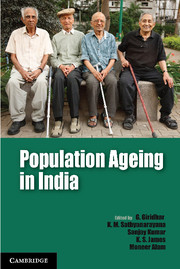Book contents
- Frontmatter
- Contents
- List of Figures
- List of Tables
- Preface
- Acknowledgements
- Introduction
- 1 Demographics of Population Ageing in India
- 2 Elderly Workforce Participation, Wage Differentials and Contribution to Household Income
- 3 Living Arrangements of Elderly in India: Policy and Programmatic Implications
- 4 Health Status of Elderly in India: Trends and Differentials
- 5 The National Policy for Older Persons: Critical Issues in Implementation
- 6 Policy Initiatives on Population Ageing in Select Asian Countries and Their Relevance to the Indian Context
- 7 Studies on Ageing in India: A Review
- Contributors
- Index
7 - Studies on Ageing in India: A Review
Published online by Cambridge University Press: 05 August 2014
- Frontmatter
- Contents
- List of Figures
- List of Tables
- Preface
- Acknowledgements
- Introduction
- 1 Demographics of Population Ageing in India
- 2 Elderly Workforce Participation, Wage Differentials and Contribution to Household Income
- 3 Living Arrangements of Elderly in India: Policy and Programmatic Implications
- 4 Health Status of Elderly in India: Trends and Differentials
- 5 The National Policy for Older Persons: Critical Issues in Implementation
- 6 Policy Initiatives on Population Ageing in Select Asian Countries and Their Relevance to the Indian Context
- 7 Studies on Ageing in India: A Review
- Contributors
- Index
Summary
Background
Population ageing is the most significant emerging demographic phenomenon in the world today. In 1950, the world population aged 60 years and above was 205 million (8.2 per cent of the population) which increased to 606 million (10 per cent of the population) in 2000. By 2050, the proportion of older persons aged 60 years and above is projected to rise to 21.1 per cent, which will be two billion in number. Asia has the largest number of world's elderly (53 per cent), followed by Europe (25 per cent). This pressure of increasing numbers of elderly will intensify in the next 50 years. In 2050, 82 per cent of the world's elderly will be in the developing regions of Asia, Africa, Latin America and the Caribbean, while only 16 per cent of them will reside in the developed regions of Europe and North America. Population ageing is therefore rapidly emerging as the problem of developing countries. Ageing was not only an Asian trend up until 2000, but it is going to continue to dominate Asia in the next century as well (UNFPA, 1999).
Old age presents its special and unique problems, but these have been aggravated due to the unprecedented speed of socio-economic transformation leading to a number of changes in different aspects of living conditions. The needs and problems of the elderly vary significantly according to their age, socio-economic status, health, living status and other such background characteristics (Siva Raju, 2002a).
- Type
- Chapter
- Information
- Population Ageing in India , pp. 180 - 214Publisher: Cambridge University PressPrint publication year: 2014
- 10
- Cited by



